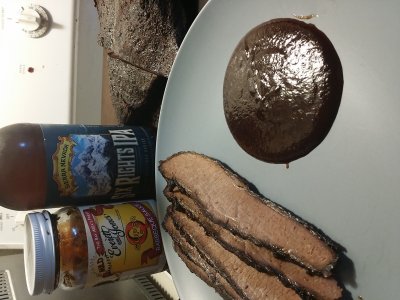Tom
New member
Something I'm continuing to work on, is whether I can continuously manage a cook by using certain techniques or methods to avoid black bark on my meat. I really am quite strongly turned off by the look of black bark on my meat and since we eat with our eyes first, to me, nothing looks better than a nice mahogany crust, whether it be brisket or pork shoulder.
Now, right off the bat, usually the first thing to avoid is cooking with sugars for a prolonged period of time, it's just a sure fire way to guarantee a black crust on your meat. In the case of a brisket, I'm not always intending to have anything brushed on the meat, sauce wise. I just serve a sauce on the side for dipping. I like the workflow of seasoning the raw meat, popping it in the smoker and pulling it out when it's done.
I cooked another brisket today that turned out to be the best yet on the 3D. Very tender, moist and flavorful. But I also have a near black crust, and I've only used a bit of yellow mustard and a rub that doesn't contain sugar.
I'm wondering if placement might help? Meaning if I put the brisket on the second from the top rather than the very top shelf, I might be able to avoid a bit of the blackening? It's only a guess, but I'm thinking the smoke that builds up right at the very top of the smoker before it leaves is sorta blanketing the meat a bit more when it's right up at the top. Maybe coming down just one shelf might help. I'll try that out on my next cook.
This was a 9.5 pound brisket that I trimmed about 0.5 pounds of fat off of, the cook started at midnight and hit 190 at 5pm, so a 17 hour cook, set at 225 the whole time, no foil. The meat was still extremely cold in the center and somewhat stiff when I started. The probe read 34 degrees when it got started.
Obviously, using too much wood could cause a black crust. I just used two double filets of smokinlicious, one cherry, one red oak. I also know foiling will tend to wash off a bit of crust from the steam build up. All together, I'd love to dial in a simple approach that gives me a non sticky crust that isn't black. Now if that requires a brushed on glaze at the end that's allowed to set, so be it. But I'll continue to hack away at other approaches until then.
Now, right off the bat, usually the first thing to avoid is cooking with sugars for a prolonged period of time, it's just a sure fire way to guarantee a black crust on your meat. In the case of a brisket, I'm not always intending to have anything brushed on the meat, sauce wise. I just serve a sauce on the side for dipping. I like the workflow of seasoning the raw meat, popping it in the smoker and pulling it out when it's done.
I cooked another brisket today that turned out to be the best yet on the 3D. Very tender, moist and flavorful. But I also have a near black crust, and I've only used a bit of yellow mustard and a rub that doesn't contain sugar.
I'm wondering if placement might help? Meaning if I put the brisket on the second from the top rather than the very top shelf, I might be able to avoid a bit of the blackening? It's only a guess, but I'm thinking the smoke that builds up right at the very top of the smoker before it leaves is sorta blanketing the meat a bit more when it's right up at the top. Maybe coming down just one shelf might help. I'll try that out on my next cook.
This was a 9.5 pound brisket that I trimmed about 0.5 pounds of fat off of, the cook started at midnight and hit 190 at 5pm, so a 17 hour cook, set at 225 the whole time, no foil. The meat was still extremely cold in the center and somewhat stiff when I started. The probe read 34 degrees when it got started.
Obviously, using too much wood could cause a black crust. I just used two double filets of smokinlicious, one cherry, one red oak. I also know foiling will tend to wash off a bit of crust from the steam build up. All together, I'd love to dial in a simple approach that gives me a non sticky crust that isn't black. Now if that requires a brushed on glaze at the end that's allowed to set, so be it. But I'll continue to hack away at other approaches until then.



